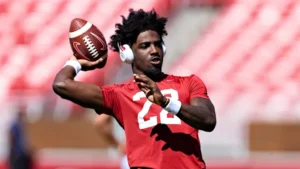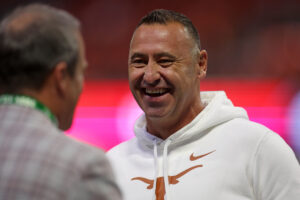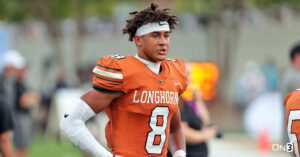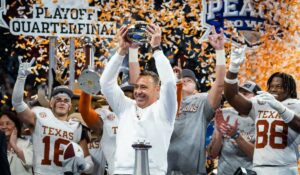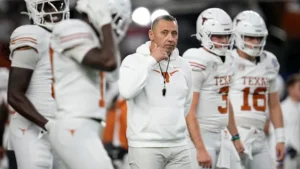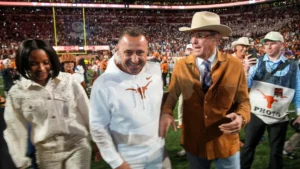
A Storm is Coming: The Shift in the Boston Celtics’ Legacy
The Boston Celtics—those storied giants of the hardwood, clad in green and white—carry a legacy unlike any other in professional basketball. With 17 championship banners fluttering in the rafters of TD Garden, shared only with the Los Angeles Lakers, they are synonymous with greatness. From Bill Russell’s unassailable dominance in the 1960s to Larry Bird’s fierce brilliance in the ’80s, the Celtics’ name is practically carved into the bones of NBA history. Yet even the strongest dynasties are not immune to the shifting tides of time. Now, in 2025, a storm brews on the horizon—one that threatens not just to challenge the Celtics’ standing, but to redefine the narrative around who they are, and what they can become.
Foundations of Glory, Cracks of Doubt
No franchise reaches greatness without evolution. The Celtics’ trajectory from the Russell era to the Bird-McHale-Parish dynasty to the “Big Three” renaissance of Paul Pierce, Kevin Garnett, and Ray Allen has always been underpinned by adaptability. And yet, in the current iteration—led by Jayson Tatum and Jaylen Brown—questions linger. Are they the next great Celtics duo, or merely placeholders between eras?
For years, pundits have hailed the Tatum-Brown tandem as the league’s most promising wing duo. Athletic, versatile, and offensively gifted, they represent the modern NBA’s stylistic ideal. But as the seasons wear on, the lack of a championship ring has become a looming specter. The 2022 Finals loss to the Golden State Warriors was a warning. The 2023 and 2024 playoff exits were alarms. Each failure chips away at the once-clear vision of a green-hued dynasty reborn.
Now, in 2025, the team stands at a crossroads—perhaps a precipice. A new storm is coming, and it is not made of wind or rain, but of pressure, scrutiny, and revolution.
The Weight of Expectations
Pressure is no stranger to Boston. The city, fiercely loyal and brutally honest, expects excellence. But as the years pass, “potential” has grown stale. Each postseason exit fuels louder conversations: Can this core get over the hump? Does Jayson Tatum have the killer instinct needed to close games in the Finals? Is Jaylen Brown more of a soloist than a complementary star? And perhaps most pressingly: Has the front office built a team that reflects the winning spirit of its history, or one caught between eras?
Brad Stevens, the front-office architect after his tenure as head coach, has made bold moves—adding Kristaps Porziņģis, reshaping the bench, and making cap-space magic to retain critical pieces. But every decision carries risk. Every bet on health, chemistry, and growth could backfire.
And that’s where the storm begins: not with poor play, but with expectations that no longer tolerate excuses.
Changing of the Guard Across the League
Elsewhere, the NBA is evolving. Young stars like Victor Wembanyama and Scoot Henderson are rising. The Oklahoma City Thunder are maturing faster than expected. The Milwaukee Bucks and Denver Nuggets remain potent forces, while the New York Knicks and Cleveland Cavaliers have made aggressive moves to rise in the East. The margin for error in Boston grows thinner each day.
Even the Golden State Warriors, once the definitive modern dynasty, have begun to fade, leaving room for new blood to dominate the narrative. The question is: Will Boston be the predator or the prey in this new landscape?
The Celtics, long perceived as one of the final bosses in the East, now find themselves part of a larger scramble—a league in flux, full of hungry challengers and shifting allegiances.
Narratives Are Shifting
Sports, like myth, is built on story. Heroes, villains, redemption arcs, downfalls—they shape our understanding of teams and players more than stats ever could. For years, the Celtics were the “next in line”—the noble heirs to a once-dominant throne. But time has a way of warping storylines.
Tatum, once compared to Kobe Bryant for his footwork and clutch shooting, is now facing questions about his leadership. Brown, awarded a massive contract, finds himself under the microscope for his dribbling, shot selection, and fit alongside Tatum. Even coach Joe Mazzulla, the youngest coach to lead a team deep into the playoffs in years, finds his seat growing warmer, as fans question his rotations and late-game tactics.
The narrative is changing: from “just a matter of time” to “is this all they are?”
If the Celtics don’t reclaim control of their story, it will be rewritten for them.
The Cultural Storm: Identity in Flux
The Celtics’ identity has always been clear—grit, defense, team-first basketball. But the modern NBA, where superstars dominate headlines and social media drives perception, has created tension. Boston isn’t glitzy like Miami. It doesn’t have the big-market buzz of LA. It doesn’t carry the blue-collar chip on the shoulder like Philadelphia. It’s something else—something harder to define in 2025.
Fans are still loyal, but even they are restless. TD Garden doesn’t tremble with the same certainty it once did. Home-court advantage feels more symbolic than strategic. In the age of player empowerment and constant movement, Boston is trying to stay rooted in tradition while navigating a game that changes almost yearly.
A storm is coming—a cultural one—that will force the team to decide what identity it carries forward. Will it evolve? Or become a relic?
The Jay-Jay Conundrum
At the eye of the storm are Tatum and Brown—the “Jay-Jays.” Their partnership, on paper, is everything you want: two elite wings, each capable of taking over games. But it’s not paper that wins rings. It’s cohesion. It’s chemistry. It’s trust.
Their on-court synergy has improved, yes. But there are still moments—late in games, under pressure—where the offense stagnates, and the team looks like two solo acts rather than a collective. Basketball is a jazz performance at its best—improvisational, connected, and emotionally resonant. But sometimes, the Celtics sound more like two trumpets playing over each other.
The storm will test them most of all. If this year ends without a Finals appearance—or worse, with another early exit—difficult questions will follow. Is it time to break up the duo? If so, who stays?
Hope in the Eye of the Storm
And yet, storms do not always destroy. Sometimes, they clear the air. They expose weakness so that it can be addressed. They demand change, and in doing so, offer rebirth.
The Celtics have the tools to weather this. Tatum is still only 27—approaching his prime. Brown, for all his flaws, is an elite two-way player. Porziņģis, when healthy, stretches defenses and protects the rim. Derrick White is among the most underrated defenders in the league. The bench is deeper than it’s been in years.
There is a version of this story—yet unwritten—where Boston does not fall, but rises. Where Tatum embraces the role of unassailable leader. Where Brown adjusts, sacrifices, and sharpens. Where Mazzulla matures into a coaching force. Where the banners in the Garden gain one more sibling.
But that version must be earned. The storm won’t pass on its own. It must be endured. And what emerges on the other side may not look like the Celtics we knew—but maybe, just maybe, it will be something greater.
The Future is Now
As spring gives way to summer, and playoff intensity rises like thunder in the distance, the Celtics stare into the storm’s eye. They’ve been here before—full of hope, talent, and the weight of legacy pressing down like humid air before a tempest. But this time feels different. Sharper. Less forgiving.
Because storms don’t wait. They come when they’re ready.
The Celtics must be ready, too.
Not just to survive—but to redefine.
